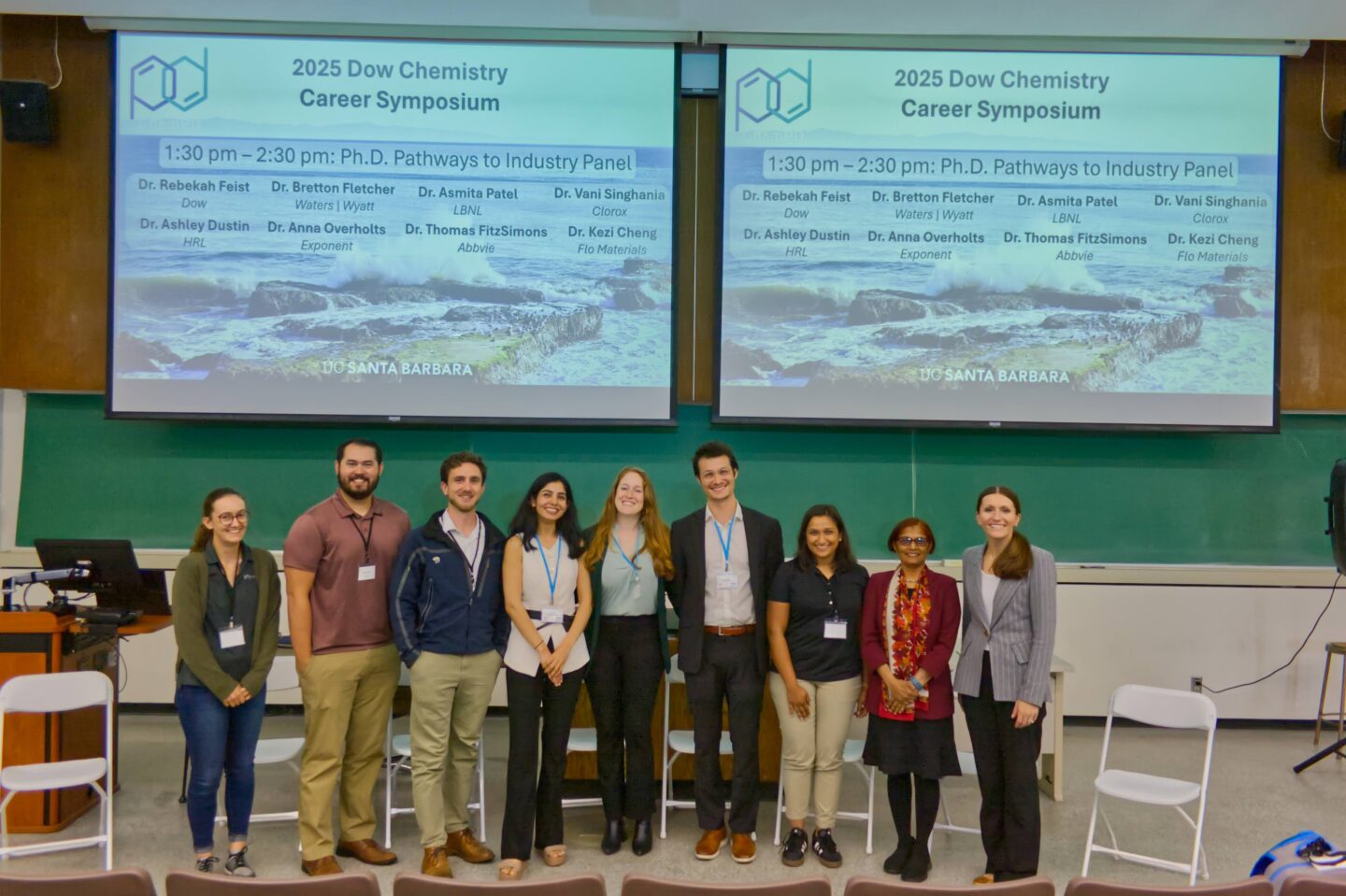The Santa Barbara (UCSB) Chemical Sciences & Engineering Career Symposium focuses on the many career opportunities opened up by an advanced degree in science: not only academic research and teaching, but also industry and the national laboratories. This annual event is hosted by ChemPD, the Chemistry Professional Development organization at UCSB.
After serving on a Career Panel at the Beyond Academia workshop in February 2019, Patel was invited to the Career Fair in September 2019, again to be part of a career panel discussion. She has participated annually ever since, describing it as “an opportunity to help outstanding young scientists explore a variety of potential career paths.”
“Asmita embodies the passion and consistency we value most in our professional development community,” says Andrea Carlini, an assistant professor in the Department of Chemistry & Biochemistry at UCSB and faculty advisor to ChemPD. “As our longest-standing participant, she represents dedication to mentorship, competitive recruitment, and the cultivation of future scientific leaders. Each year, her perspective reminds our students that career development is an active, lifelong process—one that connects curiosity with purpose.”
ChemPD’s mission is to empower graduate students and postdoctoral researchers to explore and prepare for diverse career paths across academia, industry, and government. Through research seminars, leadership workshops, career panels, and networking events, ChemPD strengthens professional connections between students, alumni, and employers—building a culture of mentorship, collaboration, and opportunity beyond the Ph.D.
The event builds lasting connections. Vani Singhania, for example, organized the Career Fair as a graduate student and invited Patel to participate in 2019 after they met at the Beyond Academia symposium. Singhania, who earned her doctorate and became an early-career scientist with The Clorox Company, participated in this year’s Career Panel discussion along with Patel and other invitees. “I was very pleased to see Vani successfully join industry as a Product Development Scientist after graduating from UCSB,” Patel said. “Success stories like hers are very inspirational to me.”


“As part of this large and prestigious event, the Career Panel is always my favorite session,” said Carlini. “It creates an open and engaging space where students can ask candid questions of professionals at different career stages, including Asmita.”
“This event is such a special opportunity for graduate students – we rarely get to connect with people from industry and national labs in such an open way,” said Komal Na, Ph.D. candidate and ChemPD co-president. “We are extremely thankful to Berkeley Lab and especially Asmita, who has been one of our longest-standing partners. She does a tremendous job every year, helping students see the range of career paths out there, and people genuinely look forward to hearing from her. I personally love her incredible advice and enthusiasm on our career panel – a huge thank you to Asmita and the entire Berkeley Lab team!”
Co-president Emile Morin added, “The enthusiastic engagement between the professional representatives from government and industry with our graduate community sets an exciting foundation for the development of future leaders and innovators. We hope to see this symposium continue to grow and provide our accomplished researchers with meaningful opportunities for professional growth. Also, I could not be more proud of the entire ChemPD leadership team for putting together yet another outstanding career symposium.”
Beyond internships and graduate school, there are many possibilities for professional careers. “These are outstanding students who will find that their degrees open many doors,” Patel said, adding, “I hope we inspired them to consider national laboratories such as Berkeley Lab. Our team-science approach offers unique opportunities for multi-institutional collaboration, mentoring, and leadership.”
“Working with graduate students and postdoctoral scholars who will soon embark on their professional careers is tremendously rewarding,” said Patel. “Their enthusiasm for science is contagious. I enjoy showing them some of the many nonacademic opportunities, and I look forward to seeing some of them at Berkeley Lab.”
Carlini said, “This year’s discussion highlighted how effective science communication is essential not only in interviews, but throughout one’s career—in leading teams, building collaborations, and fostering innovation. Panelists spoke about how clearly sharing the meaning and impact of our work strengthens both scientific progress and public understanding.”
She added, “Public trust in science depends on communication that is clear, accessible, and open—qualities that make research more relatable and its benefits more widely appreciated. For early-career scientists, these skills have become some of the most powerful tools for advancing discovery and connecting research to the needs of society. When we communicate what drives us, we have the power to inspire the world.”
For more information on ATAP News articles, contact caw@lbl.gov.
